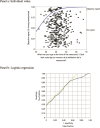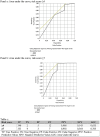Definition of a European pre-vasectomy scoring system to identify patients at risk of vasectomy regret
- PMID: 39850147
- PMCID: PMC11757006
- DOI: 10.1093/sexmed/qfae094
Definition of a European pre-vasectomy scoring system to identify patients at risk of vasectomy regret
Abstract
Introduction: Vasectomy is a widely used, safe, effective method of permanent contraception and contributes to healthy sexuality.
Aims: We have conducted a 3-step observational clinical study to develop a vasectomy regret risk score and guide patients and clinicians when discussing a vasectomy.
Methods: A 3-step approach has been followed. First, experts involved in male health have proposed risk factors for regret (remorse) after vasectomy, defined by a vasectomy reversal surgery or medically assisted reproduction. The selected factors were evaluated in 1200 patients vasectomized in the last 15 years. Finally, the expert panel has constructed a score for predicting regret after vasectomy.
Results: Fifty-two international experts identified 17 risk factors for vasectomy regret. Five of the risk factors were significant: an age <35 years old, a high Barrat Impulsivity Score, a low level of education, and a patient who didn't understand that the vasectomy might not be reversible or for whom the contraception responsibility is ideally feminine, or no responsible partner. On multivariate analysis, 3 risk factors and 2 "sine qua non" conditions were used to build the decision algorithm. A risk score ≥ 4 required information on sperm cryopreservation before vasectomy, and those with a risk score ≥ 7 required extra time for reflection. The scoring system was proposed to 52 international experts and accepted with 86.7% strongly agreeing. The model's sensitivity and specificity were 0.98 and 0.53, respectively.
Conclusion: A decisional algorithm was established to identify patients requiring information on sperm cryopreservation before vasectomy or additional time for reflection to reduce the risk of vasectomy regret. The algorithm contains 3 risk factors and 2 "sine qua non" conditions.
Keywords: male contraception; male fertility; reflection time; regret risk factors; scoring system; semen cryopreservation; vasectomy.
© The Author(s) 2025. Published by Oxford University Press on behalf of The International Society for Sexual Medicine.
Conflict of interest statement
None declared.
Figures
Similar articles
-
Vasectomy Regret or Lack Thereof.Health Psychol Res. 2022 Sep 15;10(3):38241. doi: 10.52965/001c.38241. eCollection 2022. Health Psychol Res. 2022. PMID: 36118980 Free PMC article.
-
Analysis of spermatozoa from the proximal vas deferens of vasectomized men.Int J Androl. 1994 Aug;17(4):181-5. doi: 10.1111/j.1365-2605.1994.tb01240.x. Int J Androl. 1994. PMID: 7995653
-
European countries have different rates of sperm cryopreservation before vasectomy and at the time of reversal.Andrology. 2022 Oct;10(7):1286-1291. doi: 10.1111/andr.13182. Andrology. 2022. PMID: 35396922
-
A comprehensive review of the sequelae of male sterilization.Contraception. 1983 Nov;28(5):455-73. doi: 10.1016/0010-7824(83)90077-x. Contraception. 1983. PMID: 6370585 Review.
-
Vasectomy reversal: a review on outcomes using a loupe-assisted vasovasostomy approach.Aging Male. 2020 Dec;23(5):1217-1219. doi: 10.1080/13685538.2020.1737854. Epub 2020 Mar 5. Aging Male. 2020. PMID: 32138580 Review.



